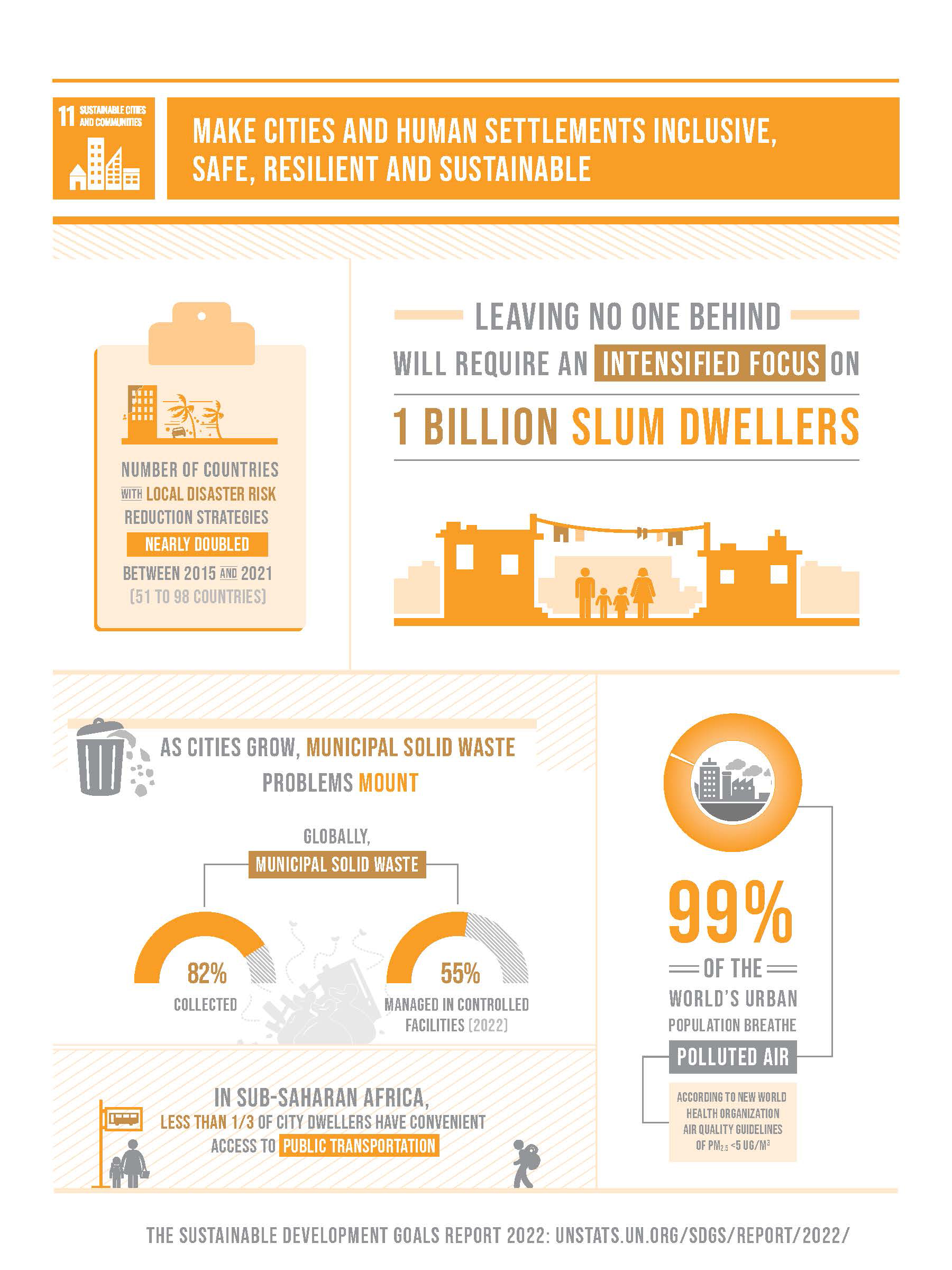Sustainable Cities
The world is becoming increasingly urbanized. Since 2007, more than half the world’s population has been living in cities, and that share is projected to rise to 60 per cent by 2030.
Cities and metropolitan areas are powerhouses of economic growth—contributing about 60 per cent of global GDP. However, they also account for about 70 per cent of global carbon emissions and over 60 per cent of resource use.
Rapid urbanization is resulting in a growing number of slum dwellers, inadequate and overburdened infrastructure and services (such as waste collection and water and sanitation systems, roads and transport), worsening air pollution and unplanned urban sprawl.
The impact of COVID-19 will be most devastating in poor and densely populated urban areas, especially for the one billion people living in informal settlements and slums worldwide, where overcrowding also makes it difficult to follow recommended measures such as social distancing and self-isolation.
The UN food agency, FAO, warned that hunger and fatalities could rise significantly in urban areas, without measures to ensure that poor and vulnerable residents have access to food.
Sustainable Development Goals
The 2030 Agenda for Sustainable Development was adopted by all United Nations Member states in 2015, an agenda that provides a shared blueprint for peace and prosperity for people and the planet, now and into the future.
The 17 Sustainable Development Goals (SDGs) are an urgent call for action by all countries – developed and developing – in a global partnership. They recognize that ending poverty and other deprivations must go hand-in-hand with strategies that improve health and quality education, reduce inequality, and spur economic growth – all while tackling climate change and working to preserve our oceans and forests. Learn more about the UN SDG’s.

What’s the goal here?
To make cities inclusive, safe, resilient and sustainable
Why?
Over 90 per cent of COVID-19 cases are occurring in urban areas, with the 1 billion residents of the world’s densely populated slums being hit the hardest. Even before the coronavirus, rapid urbanization meant that 4 billion people – over half of the global pupulation – in the world’s cities faced worsening air pollution, inade-quate infrastructure and services, and unplanned urban sprawl. Successful examples of containing COVID-19 demonstrate the remarkable resilience and adaptability of urban communities in adjusting to new norms.
What are some of the most pressing challenges that cities face today?
Inequality and the levels of urban energy consumption and pollution are some of the challenges. Cities occupy just 3 per cent of the Earth’s land, but account for 60-80 per cent of energy consumption and 75 per cent of carbon emissions. Many cities are also more vulnerable to climate change and natural disasters due to their high concentration of people and location so building urban resilience is crucial to avoid human, social and economic losses.
Why should I care?
All these issues will eventually affect every citizen. Inequality can lead to unrest and insecurity, pollution deteriorates everyone’s health and affects workers’ productivity and therefore the economy, and natural disasters have the potential to disrupt everyone’s lifestyles.
What happens if cities are just left to grow organically?
The cost of poorly planned urbanization can be seen in some of the huge slums, tangled traffic, greenhouse gas emissions and sprawling suburbs all over the world. By choosing to act sustainably we choose to build cities where all citizens live a decent quality of life, and form a part of the city’s productive dynamic, creating shared prosperity and social stability without harming the environment. As of May 2020, the majority of national and city governments are revisiting urban planning to help prevent the next pandemic.
9 in 10 people living in urban areas worldwide were breathing air that did not meet the World Health Organization’s air quality guidelines
Is it expensive to put sustainable practices in place?
The cost is minimal in comparison with the benefits. For example, there is a cost to creating a functional public transport network, but the benefits are huge in terms of economic activity, quality of life, the environment, and the overall success of a networked city.
What can I do to help achieve this goal?
Take an active interest in the governance and management of your city. Advocate for the kind of city you believe you need.
Develop a vision for your building, street, and neighborhood, and act on that vision. Are there enough jobs? Can your children walk to school safely? Can you walk with your family at night? How far is the nearest public transport? What’s the air quality like? What are your shared public spaces like? The better the conditions you create in your community, the greater the effect on quality of life.
United Nation Sustainable Development Goals
(United Nations why it matters)
Facts and Figures
- Half of humanity – 3.5 billion people – lives in cities today and 5 billion people are projected to live in cities by 2030.
- 95 per cent of urban expansion in the next decades will take place in developing world
- 828 million people live in slums today and most them are found in Eastern and South-Eastern Asia.
- The world’s cities occupy just 3 per cent of the Earth’s land, but account for 60-80 per cent of energy consumption and 75 per cent of carbon emissions.
- Rapid urbanization is exerting pressure on fresh water supplies, sewage, the living environment, and public health.
- Cities account for between 60 and 80 per cent of energy consumption and generate as much as 70per cent of human-induced greenhouse gas emissions
- 90 per cent of urban growth is forecasted to happen in Asia and Africa in the next 30 years.
- By 2050 70 per cent of the world population is predicted to live in urban settlements.
Goal 11 targets
- 11.1 By 2030, ensure access for all to adequate, safe and affordable housing and basic services and upgrade slums
- 11.2 By 2030, provide access to safe, affordable, accessible and sustainable transport systems for all, improving road safety, notably by expanding public transport, with special attention to the needs of those in vulnerable situations, women, children, persons with disabilities and older persons
- 11.3 By 2030, enhance inclusive and sustainable urbanization and capacity for participatory, integrated and sustainable human settlement planning and management in all countries
- 11.4 Strengthen efforts to protect and safeguard the world’s cultural and natural heritage
- 11.5 By 2030, significantly reduce the number of deaths and the number of people affected and substantially decrease the direct economic losses relative to global gross domestic product caused by disasters, including water-related disasters, with a focus on protecting the poor and people in vulnerable situations
- 11.6 By 2030, reduce the adverse per capita environmental impact of cities, including by paying special attention to air quality and municipal and other waste management
- 11.7 By 2030, provide universal access to safe, inclusive and accessible, green and public spaces, in particular for women and children, older persons and persons with disabilities
- 11.A Support positive economic, social and environmental links between urban, peri-urban and rural areas by strengthening national and regional development planning
- 11.B By 2020, substantially increase the number of cities and human settlements adopting and implementing integrated policies and plans towards inclusion, resource efficiency, mitigation and adaptation to climate change, resilience to disasters, and develop and implement, in line with the Sendai Framework for Disaster Risk Reduction 2015-2030, holistic disaster risk management at all levels
- 11.C Support least developed countries, including through financial and technical assistance, in building sustainable and resilient buildings utilizing local materials
Links:
UN Environment Programme : Cities – investing in energy and resource efficiency
UN Environment Programme Climate Neutral Network
UN Environment Programme: Cities and Climate Change
UN Population Fund: Urbanization
ICLEI – Local Governments for Sustainability
We, at AI for Good foundation, are using AI + ML initiatives in pursuit of the 17 SDGs. With various projects in progress, such as our Intelligent Cities and the Intelligent Countries, we are determined to help and facilitate achieving the goals.







